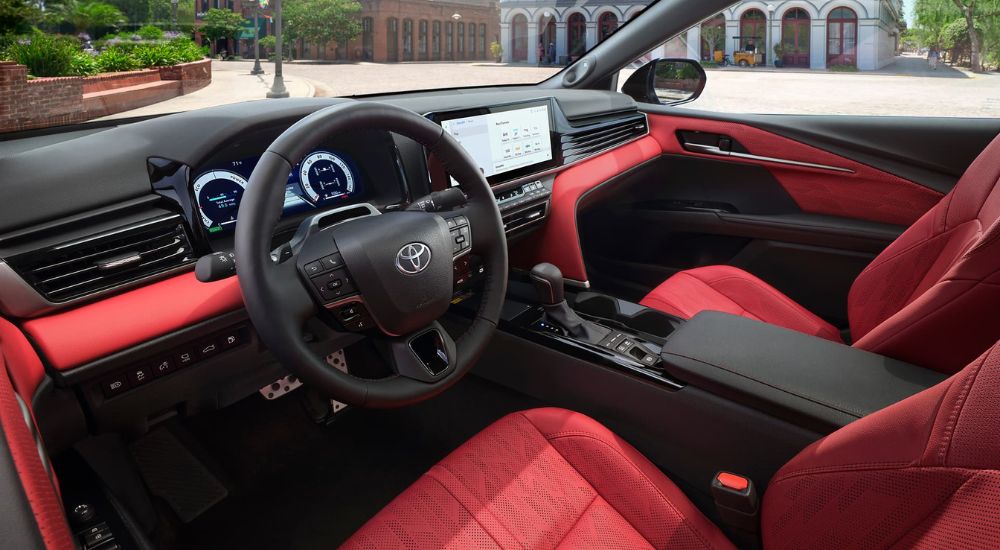While some automakers are turning away from sedans entirely and producing SUV-only lineups, Toyota still has a full lineup of sedans, ranging from the compact Corolla to the full-size Crown. Nestled between the two, you’ll find the midsize Camry, which offers more interior space than the Corolla while being more affordable and nimble than the Crown—and not only can you still easily find the Toyota Camry for sale at dealerships across the country, but Toyota is invested enough in its sedans to give this model a complete refresh for 2025.
The 2025 Camry marks the start of this model’s ninth generation, and that means changes inside and out. But what exactly differentiates this model from the 2024 one? Is it worth waiting for if you’re considering buying one in the near future? We’ll dig in and get you the details you need to make an informed decision in this guide to the new-and-improved Camry…
Hybrid Efficiency Comes Standard
Perhaps the most significant change is the fact that the 2025 Camry is a hybrid, no matter what trim level you opt for. The Camry Hybrid has been around for years, but until now it’s always been available alongside a traditional gas-powered hybrid. But with electrification gathering steam, the Camry is going all-in on hybrid technology. Since Toyota has a lot of experience making reliable hybrid powertrains, even first-time hybrid buyers should be able to shop with confidence.
The 2025 Camry’s powertrain is a traditional hybrid, not a plug-in hybrid, so you don’t need charging infrastructure in your area to take advantage of its impressive fuel economy. While exact figures for the 2025 Camry’s fuel economy aren’t out yet at the time of this writing, note that the 2024 Camry Hybrid’s 52 MPG combined fuel economy rating is exactly double the rating of the non-hybrid Camry that same year, at 26 MPG combined.
The standard hybrid powertrain pairs a 2.5L four-cylinder engine with a pair of electric motors, coming together to produce 225 hp. That setup uses front-wheel drive, which was the only available drivetrain for the 2024 Camry Hybrid. But for the 2025 model year, drivers also have the option to upgrade to an electric on-demand AWD system that adds a third motor to the vehicle and brings the total power up to 232 hp. The on-demand system aims to deliver the best of both worlds, giving you efficient FWD when conditions are good and engaging AWD to provide extra traction when roads are wet or unpaved.

A Fresh New Look
No vehicle’s new generation would be complete without a fresh new look, and the ninth-gen Camry is no exception. This redesign focuses on making the car look both athletic and sleek, leaning into what drivers are hoping for when they choose a sedan over an SUV. The front fascia has a bolder, more modern look to it and the headlights are sleeker, following the latest automotive trends made possible with LEDs, which can be effective even when they don’t take up very much space.
Two new paint colors have been added to the lineup: Ocean Gem and Heavy Metal. On the top-tier XSE trim, you can get a two-tone look thanks to an available Midnight Black Metallic roof. The black roof can be paired with either of the two new colors—Wind Chill Pearl or Supersonic Red—providing an eye-catching contrast.
The makeover continues inside the cabin, with each trim getting its own new look. The base SE gets SofTex-trimmed seats that are either gray or black with white accents. Upgrading to the XSE gets you standard leather trim available in either black with blue-lined perforations or a bold red that gives the cabin a sports-car feel. In the LE, there’s a woven fabric with embossed patterns throughout, while the XLE gets light gray or black leather and microfiber-trimmed seats.
Throughout the lineup, the seats have been adjusted, with different shapes, densities, and cushion lengths designed to increase comfort. The upper-tier XLE and XSE trims can be had with a panoramic sunroof with a power-retractable shade—a first for the Camry Hybrid.
Upgraded Tech
The 2024 Camry could be had with either a 7.0- or 9.0-inch infotainment touchscreen and either a 4.2- or 7.0-inch multi-information display behind the steering wheel. Both of these displays get larger versions for the 2025 Camry, which comes standard with an 8.0-inch infotainment screen and 7.0-inch digital instrument cluster and is available with a 12.3-inch infotainment screen and 12.3-inch digital instrument cluster. Bigger screens make it easier to see camera views at a glance and allow for more information to be on-screen at once.
While the digital instrument cluster behind the wheel is easy to check without taking your eyes off the road for long, you can keep them on the road completely with the available 10.0-inch head-up display, which projects metrics directly onto the lower windshield and isn’t completely opaque, so you can see right through it and keep an eye on the traffic ahead while checking your upcoming navigation directions or getting a safety warning.
Wireless Apple CarPlay and Android Auto connectivity is standard across the trim lineup. For the first time, a wireless charging pad is also standard across all trims—but while going completely cable-free is possible, there are still plenty of USB-A and USB-C ports throughout the cabin, with three up front and two for rear-seat passengers. You can also connect up to two devices at a time via Bluetooth.
Improved Comfort
Not every change is visible; some are hiding under the surface and can only be noticed when the car is in motion. That’s the case with the Camry’s re-engineered suspension and braking system, both of which are designed to improve handling for a more comfortable ride. Speaking of comfort, dual-zone automatic climate control with rear-seat vents is now standard across the lineup, so passengers throughout the vehicle can stay comfortable no matter the weather.

High-Tech Safety
Toyota’s suite of driver assistance technology, Toyota Safety Sense (TSS), has been updated several times since it was first released. While the 2024 Camry used TSS 2.5+, the 2025 model comes standard with TSS 3.0. The new system uses a better forward-facing camera that’s both higher-definition and has a wider field of view paired with an improved radar sensor.
These upgrades enhance features that were already part of the package, like the pre-collision system with pedestrian detection, lane departure alert with steering assist, lane tracing assist, and dynamic radar cruise control, making them more accurate. In addition to hardware upgrades, TSS 3.0 is also capable of over-the-air software upgrades, so it can improve over time as new upgrades are made to the system’s code.
The road sign assist feature can now recognize more types of road signs than before, making it more useful in a wide variety of situations. Automatic high beams see no changes but still come standard in the suite. In addition to the enhanced features, there’s also an entirely new feature called proactive driving assist, which can work alongside your driving instincts to provide gentle braking and supportive steering to help you keep your distance from other vehicles, pedestrians, and bicyclists, and doing so while going around curves. Blind-spot monitoring and rear cross-traffic alert were both available features for the 2024 Camry, and they come standard across all trim levels for the 2025 model.
Dramatic Changes Move the Camry Forward
It’s clear that this new generation is arriving with a complete overhaul, not just a surface-level makeover. Not only is the Camry becoming a die-hard hybrid, but it’s getting a new infotainment system, upgraded driver assistance suite, and significant redesigns inside and out. Drivers who like to take advantage of the latest automotive features might well want to hold off on getting a new Camry until they can bring home a 2025 model because it looks like it will be worth the wait.



